It’s embellishment time on the Historical Sew Fortnightly. Time to trim, ornament, adorn, frill, bedeck, garnish, festoon, and gild to your hearts content.
It’s also time for a confession. I have trouble with embellishment. I like the idea of embellishment, I like it when I see it on historical gowns, but when I get a gown finished, but un-trimmed, I love the silhouette and simplicity so much I just can’t make myself finish the trim and change the clarity of line.
So I’m hoping to use this challenge to finally make myself trim some of the un-embellished items I have sitting around. And I’m hoping all these pretty embellished pieces reconcile me to some historical maximalism!
Like Elisabeth’s fabulous lace trimmed ruff, bejewelled headdress, and garnished partlet and dress. I’m not usually a fan of late 16th century fashions, but the ornamentation of her dress is so perfectly balanced with the simplicity of her face, and with all the other embellishments.

Elisabeth of Austria (1554—1592) Queen of France, ca. 1571, by François Clouet (1515—1572)
Late 17th century fashion can also be a bit hit-or-miss, but this frock marries the ribbon tabs and lace of the full chemise sleeves, the richly patterned skirt (pattern is, after all, a form of ornamentation), and the jewelled tie backs in such a delightfully romantic fashion.
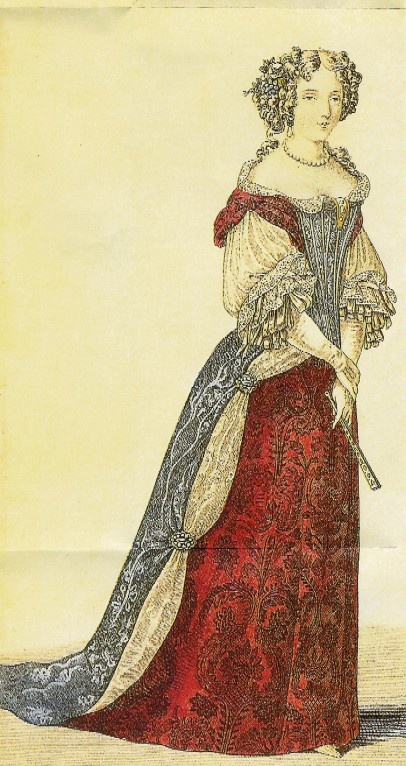
French fashions, 1690s
The 18th century is all about embellishment, and I love that men got in the act. If I could embroider like this I’d probably be far more enthusiastic about embellishing everything!
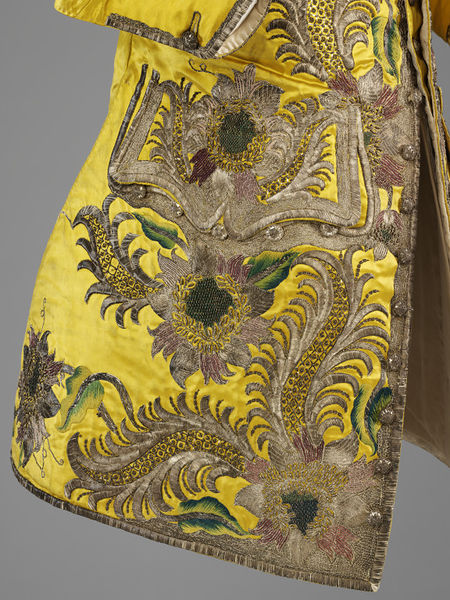
Waistcoat, England, Date- 1730-1739 (made) Silk satin, silver thread, spangles, silk thread; hand-sewn and hand-embroidered, V&A
Since my embroidery skills are sadly lacking, I’ll have to content myself with 18th century lace, bows, ruffles and fly fringing and passimentarie.
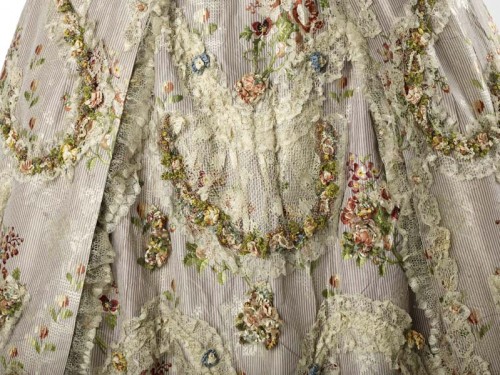
Robe a la Francaise, 1762-1767, silk taffeta with ribbons and lace, Museum of London
Even the simple white frocks of the turn of the 19th century were embellished – usually white, but this polychrome and gilded example is delightful.
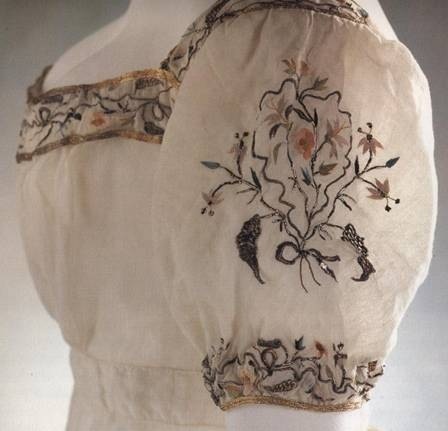
Muslin evening dress 1812-1815. Embroidered with single strands of very fine silk, the stalks are embroidered in silver gilt thread
I also love the simple 1840s frocks with their deep lace-trimmed skirt tiers. They clearly have links to Queen Victoria’s lace trimmed wedding dress of 1840, but I’ve also rread period references that call them ‘Boston dresses’ as they were apparently favoured by the elite ladies of that city. I wouldn’t be surprised if they were also called Winterhalter dresses, as he was so fond of painting the grand ladies of Europe in that style of embellished frock.
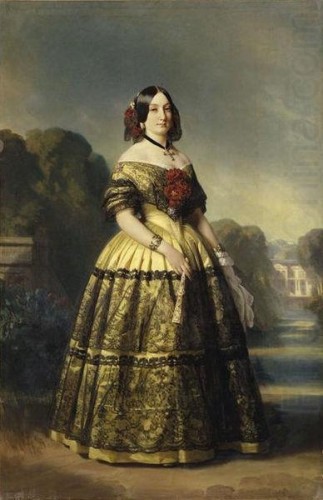
Maria Luisa von Spanien, 1847, Franz Xaver Winterhalter
It’s not just pretty ballgowns that can be embellished. I’m fascinated by the tasselled trim on this 1860s mantle

Wool mantle with silk embroidery and tasseled fringe, late 1860’s, Metropolitan Museum of Art
And the embroidery and piecing on this 1880s jacket. Wow.
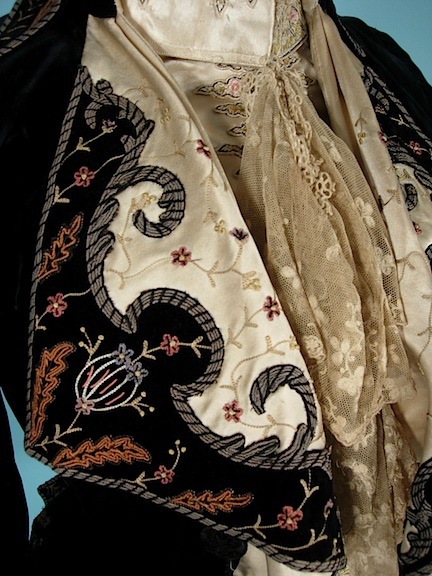
Black velvet embroidered fancy walking jacket, 1884, Arnold Constable, Antique Dress
The late Victorians just loved embellishment. Just checkout the hecka everything going on on this dress:

Evening dress, Jacques Doucet, ca. 1902, French, silk, linen, Metropolitan Museum of Art
If that is too much, what about this amazing chenille embroidery from the designer who (to my mind at least) brought a mastery of embellishment to her garments which no other designer has come close to matching:

Jolibois, House of Lanvin (French, founded 1889), Jeanne Lanvin, fall-winter 1922—23, French, silk, Metropolitan Museum of Art
Let’s finish off with another bit of subtle embellishment, in the form of 1930s colour-play trim.
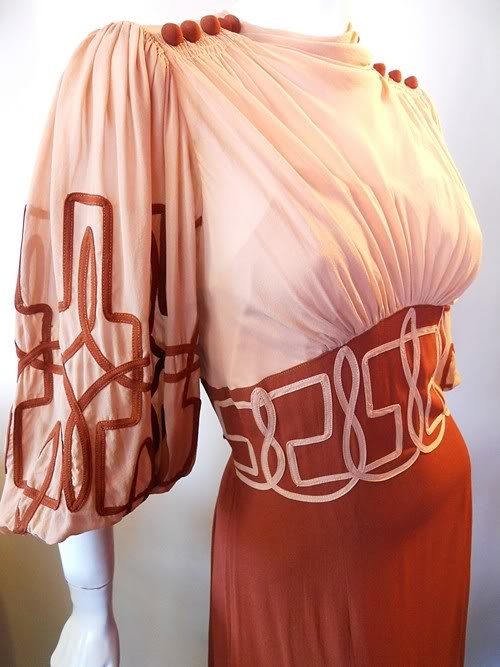
1930s dress, DCV archives

Absolutely love the 1930s dress, both the trim and the buttons. The Victorian dress has a bit too much going on for me!
Happy sigh. That was like tasting my way through a really good quality box of assorted chocolates! I’m a ‘sew on the braid’ kind of embellisher, myself, and it has always made me a little sad that the friends I have who are wonderful at embroidery seem to stick to embroidering pictures and show no enthusiasm at all for embroidering clothes for themselves.
That eighteenth century waistcoat! The embroidery looks wonderful on that rich yellow. And weren’t those Victorian skirts a wonderful way to display good lace? So nicely spread over the skirt so that you could see all the beautiful work, not all bunched up.
True story: I never–ever–wear patterns. I just don’t. This challenge would scare me, too!
But some of the pictures that you show are just soooo achingly beautiful, and others are soooo disarmingly charming…I would be able to be persuaded….
Good luck! Looking forward to the finished product!
Well, embellishment doesn’t have to be pattern – it can be any sort of trim. Pleating, ruffles, beading, tone-on-tone embroidery, or applied ribbon or braid. And I just won’t believe it if you never wear any of those!
Nope. Seams. That’s as close as I get–ha!
But you are right: There are so many ways to be creative with embellishments, and there is always a way to make it fit. My linen sweater has wide cuff/hems at the end of the sleeve. So…ok you’re right.
That pos/neg 1930s dress really is something! Gorgeous dress too!
I have the same problem with embellishment. I love the idea of it, I love how it looks, and I love to see examples of it (I have a “more is more” type of personality), but I don’t do it. Partly it’s due to a dreadful combination of time constraints and a naturally short attention span. It’s also partly because I have a niggling suspicion that if I tried to wear it I’d look silly, but I do want that 30s dress. I want it very much. I love the use of positive/negative. I also want the waistcoat. I would totally wear that to the office.
I am reminded of my favorite Mae West quote, “Too much of a good thing is just about right.” I just love that Mae West. One reason I love Godey’s Ladies’ Book and Magazine and Peterson’s Magazine is because I love all the elaborately decorated trinkets, and clothing. It’s fun to challenge myself to make these items and find a use for them in my home. I’m very ecclectic in my tastes, and all the little frillies are delightful. My nieces love to look around and try to figure out what pieces are new.
One of my favorite things to do for my nieces (and for wedding parties) is to make the same dress for each, but embellish each differently according to each one’s personality, or make each a different style but use the same embellishments to tie them together. I also love to make elaborate christening / burial gowns using fabric and trims from old bridal gowns that the local resale shop gives to me. What often won’t sell because it’s out of style, gets new life and brings joy to the families that they are donated to.
I love to embellish things and usually the only thing that holds me back is finances. I deal with the short attention span theater by having multiple projects going, so I can switch off between them if I get bored or frustrated. I also hate just sitting and hemming endless length of fabric for ruffles and frills, since most of what I need is for that is very fine, white linen, I deal with it by cutting lengths to width, starching the daylights out of it, and rolling it to store in a separate work box, along with pre-cut, pre-waxed lengths of thread, and a thimble. Whenever I have some time (often while movies are playing or friends, who understand the need to sew, are over) I pull over the box and start sewing. I also keep wider widths of linen, with the embroidery designs already marked in fine line white paint (they make pens for that), along with the silk, linen, cotton, or wool that will be used, packages together as kits. I also keep various lengths of stretcher bars (available at any framing/art supplies store) gathered nearby, along with stainless steel tacks. When the mood strikes, I just lock the appropriate lengths together and stretch and tack the linen to the frame and start stitching. As you can tell, I have many projects lined up in advance. I’ve been researching, planning and acquiring materials and tools since I was about twelve. Some embroideries have been finished but the making up put off because of changes in size, or the need for additional notions for making up. Some are works in progress, or haven’t had a stitch sewn yet. But, I will never be at a loss for something to do because I don’t have anything on hand or ready to go. All this means that I don’t view the embellishments for a garment as optional but as an integral part of the garment, and it’s doable.
Happily fancy stitching along,
Yvonne
Your friends and nieces are so lucky to receive your creations! How cool!